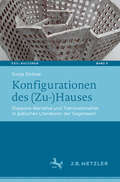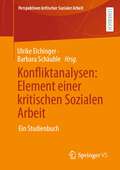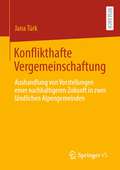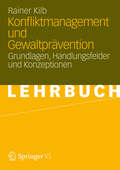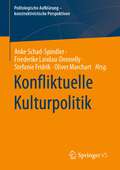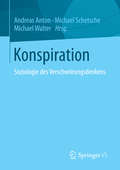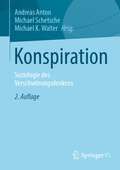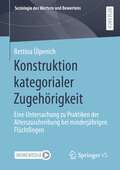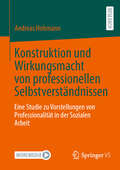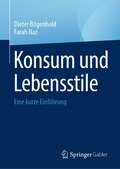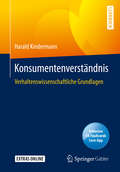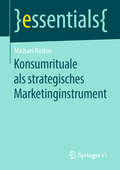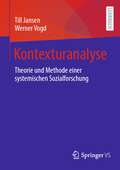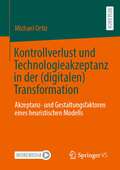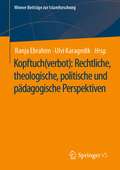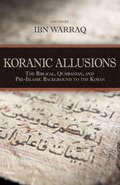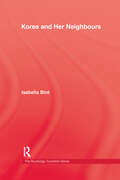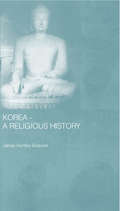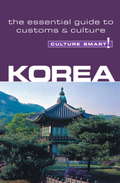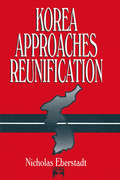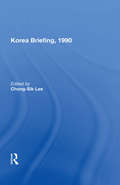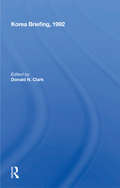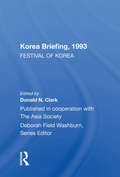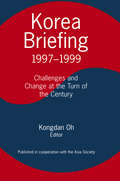- Table View
- List View
Kon-Tiki: Across the Pacific by Raft
by Thor HeyerdahlThis book recounts a groups' travels across the Pacific ocean on a raft
Konfigurationen des: Diaspora-Narrative und Transnationalität in jüdischen Literaturen der Gegenwart (Exil-Kulturen #3)
by Sonja DickowDie komparatistische Studie arbeitet anhand von Parallellektüren deutsch-, englisch- und hebräischsprachiger Gegenwartstexte den Befund heraus, dass gerade an der Konfiguration des immobilen Hauses Mehrfachverortung und Grenzüberschreitung verhandelt werden. Das Zuhause verliert durch die Zerstörungen der Shoah und die Exilerfahrungen der jüdischen Figuren seine Funktion als Heimat und Ort der Stabilität und Kontinuität. Erinnerndes Erzählen und Traditionen des diasporischen Schreibens werden dagegen als Orte der Zugehörigkeit diskutiert. Der in der mehrsprachigen jüdischen Literaturgeschichte ohnehin angelegte Transnationalitätsdiskurs wird in Untersuchungen zu Nicole Krauss und Anna Mitgutsch, Jenny Erpenbeck und Eshkol Nevo, Michal Govrin und Barbara Honigmann aufgerufen.
Konfliktanalysen: Ein Studienbuch (Perspektiven kritischer Sozialer Arbeit #32)
by Ulrike Eichinger Barbara SchäubleDas Buch stellt Konflikte aus verschiedenen Arbeitsbereichen Sozialer Arbeit vor, die subjekt- und bereichsorientiert mittels unterschiedlicher konflikttheoretischer und -methodischer Ansätze ausgeleuchtet werden. Zudem werden Formen der Konfliktbearbeitung analysiert. Hierdurch wird die Vielfalt und das Potenzial konfliktanalytischer Perspektiven für das Studium zugänglich(er) gemacht und das Orientieren in arbeitsbereichsspezifischen Widersprüchen für eine kritische (Professionalisierungs-)Praxis unterstützt.
Konflikthafte Vergemeinschaftung: Aushandlung von Vorstellungen einer nachhaltigeren Zukunft in zwei ländlichen Alpengemeinden
by Jana TürkJana Türk untersucht in ihrer qualitativen Studie, wie Akteure in zwei ländlichen Alpengemeinden nachhaltige Entwicklung aushandeln. Dabei nimmt sie unterschiedliche lokale Entwicklungsprozesse in den Blick und rekonstruiert anhand von leitfadengestützten Interviews, ethnographischen Beobachtungen und weiteren Dokumenten kollaborative und konflikthafte Aushandlungsprozesse und welche Rolle Gemeinwohl im Umgang mit den lokal wirksamen Dynamiken sozial-ökologischen Wandels spielt.
Konfliktmanagement und Gewaltprävention
by Rainer KilbKonfliktbearbeitung und Gewaltprävention sind heute zentrale Aufgaben in zahlreichen Handlungsfeldern von Sozialer Arbeit aber auch des schulischen Alltags. Ein professioneller Umgang mit dem Phänomen zählt somit zu den erwarteten Handlungskompetenzen der pädagogischen Fachkräfte und sollte bereits im Studium vermittelt, erprobt und auch trainiert werden. Das Buch vermittelt die theoretischen Grundlagen als auch eine Übersicht wichtiger Konzeptionen und Handlungsansätze.
Konfliktuelle Kulturpolitik (Politologische Aufklärung – konstruktivistische Perspektiven)
by Oliver Marchart Anke Schad-Spindler Friederike Landau-Donnelly Stefanie FridrikDieser Sammelband vereint Beiträge aus unterschiedlichen Bereichen der Kulturpolitikforschung. Impulsgebend für den Band war das Forschungsprojekt „Agonistische Kulturpolitik (AGONART) – Fallstudien zur konfliktiven Transformation von Kulturstandorten“. Dieses verstand sich als interdisziplinärer Beitrag zwischen qualitativ-empirischer Grundlagenforschung in Politikwissenschaft (mit Schwerpunkt auf Kulturpolitik) und politischer Theorie (mit Schwerpunkt auf Konflikttheorie bzw. agonistischer Demokratietheorie). Das Buch regt somit zu einer wissenschaftlichen Auseinandersetzung mit Kulturpolitik(forschung) in Österreich, dem deutschsprachigen Raum und darüber hinaus an.
Konspiration
by Andreas Anton Michael Schetsche Michael K. WalterVerschwörungstheorien genießen in der Bevölkerung große Popularität. In den Wissenschaften haben sie hingegen einen eher schlechten Ruf - den Leitmedien gelten sie als Ausdruck überzogenen politischen Misstrauens oder gar kollektiver Paranoia. Der vorliegende Band erklärt, wie diese unterschiedliche Bewertung zustande kommt und woraus der anhaltende Erfolg von Verschwörungstheorien in der Öffentlichkeit resultiert. Mittels empirischer Fallstudien, medienwissenschaftlicher Rekonstruktionen und theoretischer Reflexionen wagt der Band den Versuch einer soziologischen Ehrenrettung des konspirologischen Gegenwartsdenkens.
Konspiration: Soziologie des Verschwörungsdenkens
by Andreas Anton Michael Schetsche Michael K. WalterSpätestens seit der Corona-Pandemie werden Verschwörungstheorien zunehmend als gesellschaftspolitisches Problem wahrgenommen und sind zum Politikum geworden. Wohl noch nie zuvor gab es im öffentlichen Diskurs eine derart hohe Sensibilität für das Thema. Ängste vor Verschwörungen einerseits und Ängste vor Verschwörungstheorien andererseits schaukeln sich offenbar gegenseitig hoch. Dies führt zu einer anwachsenden gesellschaftlichen Polarisierung und zu einem Klima von Misstrauen, Empörung und Gereiztheit. Zehn Jahre nach der Erstauflage des vorliegenden Bandes erscheint die Analyse des gegenwärtigen Verschwörungsdenkens dringender denn je. Im Rahmen von sechs neuen Beiträgen nimmt die erweiterte Neuauflage aktuelle Entwicklungen in den Blick. In Kombination mit den ursprünglichen Aufsätzen soll so zu einem umfassenden und differenzierten Bild des sozialen Phänomens Verschwörungstheorien beigetragen werden.
Konstruktion kategorialer Zugehörigkeit: Eine Untersuchung zu Praktiken der Alterszuschreibung bei minderjährigen Flüchtlingen (Soziologie des Wertens und Bewertens)
by Bettina ÜlpenichDie Inobhutnahme nach unbegleiteter Einreise aus dem Ausland wird im Zuge aktueller Migrationsbewegungen zu einer Hauptaufgabe deutscher Jugendämter. Diese haben in der Inobhutnahme zu prüfen, wem die Maßnahmen der Jugendhilfe rechtmäßig zukommen. Alterszuschreibungen werden in diesem Kontext zu einer kritischen Bewertung, die Jugendliche zum Teil der Personenkategorie der unbegleiteten minderjährigen Flüchtlinge macht und andere davon ausschließt.Diese soziologische Analyse macht sich das administrative Verfahren der Inobhutnahme zum Gegenstand und fragt, wie Personen Teil obiger Personenkategorie werden. Inobhutnahmen nach unbegleiteter Einreise aus dem Ausland erscheinen hier als aktiv hervorgebrachter und konfliktiver Zuschreibungsprozess, dessen jeder neue Schritt neue Unsicherheiten erzeugt und jeder Beobachtung eine Vorläufigkeit einschreibt. Anhand der wissenssoziologischen Rekonstruktion von Einsichtnahmen in Ausweispapiere, Inaugenscheinnahmen und ärztlichen Untersuchungen macht die Analyse die administrative Realisierung von Ordnung sichtbar. Alterszuschreibungen erfolgen hier vor dem Hintergrund und in Auseinandersetzung mit westlich-hegemonialen Ideen über das Alter einer Person. Die Analyse des Inobhutnahmeverfahrens verhilft damit einem Merkmal zu Sichtbarkeit, über das Personen nur unter ganz bestimmten Umständen verfügen können.
Konstruktion und Wirkungsmacht von professionellen Selbstverständnissen: Eine Studie zu Vorstellungen von Professionalität in der Sozialen Arbeit
by Andreas HohmannKanonische Studien im Professionalisierungsdiskurs der Sozialen Arbeit legen den Schluss nahe, dass nicht vorausgesetzt werden kann, dass Hochschulabsolvent*innen einschlägiger Fachstudiengänge der Sozialen Arbeit die Entwicklung von Professionalität per se als sinnhaftes berufliches Entwicklungsziel für sich akzeptieren. Das bedeutet jedoch nicht, dass Professionalität für Praktiker*innen per se kein relevantes Thema darstellt. Anzunehmen ist eher, dass Professionalität für sie mit spezifischen Relevanzen besetzt ist. Der Autor rekonstruiert in dieser qualitativen Studie mit einer Triangulation von zwei hermeneutischen Methoden, wie Praktiker*innen der Sozialen Arbeit ihr professionelles Selbstverständnis als subjektive Vorstellungen von Professionalität narrativ konstruieren. Das Interesse der Studie gilt darüber hinaus der Frage, welche bildhaften Sinnstiftungsmuster diese Konstruktion sinnhaft anleiten. Der Blick auf professionelle Selbstverständnisse als Sinnkonstruktionen und Ordnungsleistungen des Individuums schärft den Blick dafür, unter welchen Bedingungen Professionalität für Praktiker*innen der Sozialen Arbeit zu einem sinnstiftenden Projekt wird, in das es sich in Form von Zeit, Energie, Fortbildung, Reflexion, etc. zu investieren lohnt. Die Arbeit elaboriert den Begriff des professionellen Selbstverständnisses als analytisches Konzept für den Professionalisierungsdiskurs Sozialer Arbeit.
Konsum und Lebensstile: Eine kurze Einführung
by Dieter Bögenhold Farah NazIn diesem Buch wird ein interdisziplinärer Ansatz für die Welt des Konsums gewählt, der verschiedene Themen abdeckt und soziologische, wirtschaftliche und marketingbezogene Aspekte einbezieht. Der Begriff "Konsum" ist vage, und selbst in den akademischen Disziplinen wird der Begriff auf unterschiedliche Weise verwendet. Die Konsumforschung fragt, wie Einkommen und Ausgaben miteinander zusammenhängen. Ganz allgemein untersucht die Konsumforschung, wie Menschen, soziale Schichten oder Gesellschaften ihre Konsumgewohnheiten realisieren. Häufig wird die Frage gestellt, wie konsistent Präferenzstrukturen aufgrund wechselnder empirischer Hintergründe von Zeit, Raum und damit verbundener Kultur sind. Welche Kontextvariablen (historischer Zeitpunkt, geographischer Rahmen, kultureller Hintergrund) spezifizieren die Praxis des Konsums und in welcher Weise haben Merkmale wie Alter, Geschlecht, Klasse, Beruf und Lebensstil eigene Auswirkungen auf die Art und Weise, wie Konsum realisiert wird?Das Buch ist für Forscher aus den Bereichen Ökonomie, Soziologie, Marketing, Ästhetik und Design, Anthropologie und Kommunikationswissenschaft von Interesse.
Konsumentenverständnis: Verhaltenswissenschaftliche Grundlagen
by Harald KindermannDas Ziel dieses Buches ist es, aus interdisziplinärer Perspektive ein Verständnis über den Menschen als Konsument im digitalen Zeitalter aufzubauen. Es hilft uns zu verstehen, welche Kräfte und Motive uns antreiben und was unser Tun beeinflusst. Harald Kindermann zeigt, wie wir dieses Konsumentenverständnis auf wirtschaftliche Fragestellungen eines Unternehmens – und insbesondere für die Ausgestaltung der marketingpolitischen Instrumente – umlegen können. Der Autor vermittelt dem Leser das notwendige Basiswissen, damit er beurteilen kann, ob Produkte, Marken sowie die Ausgestaltung der Kommunikationspolitik tatsächlich die Bedürfnisse der Konsumenten treffen oder am intendierten Ziel vorbeischießen. Das Kapitel zu den physiologischen und anatomischen Grundlagen wurde mit der Unterstützung von Dr. Dr. Andrija Javor, Facharzt für Neurologie in Zug, Schweiz, verfasst.Mit diesem Buch können Sie mit der kostenlosen Springer Nature Flashcards-App auf exklusives Zusatzmaterial zugreifen, um Ihr Wissen zu prüfen.Der Inhalt- Die Evolution als Basis für unser Verhalten- Signale, Partnerwahlstrategien und unser Selbstkonzept- Wichtige physiologische und anatomische Grundlagen- Gedächtnis- Wahrnehmung und Interpretation von Informationen- Lernen- Entscheidungen und Beeinflussungen- Konsumentenverständnis und Marketing
Konsumrituale als strategisches Marketinginstrument (essentials)
by Michael RoslonKonsumrituale stellen ein randständiges Forschungsgebiet der (Konsum-)Soziologie dar, was insofern erstaunlich ist, als dass die Ritualforschung eine etablierte Größe in den Sozial- und Kommunikationswissenschaften darstellt. Aus diesem Grund zielt Michael Roslon mit diesem essential darauf ab, die Erkenntnisse der Ritualforschung auf die Analyse von Konsumhandlungen zu übertragen. Auf diese Weise können Unternehmen wichtige Consumer Insights generieren, die sie im Rahmen ihrer Kommunikationsanstrengungen gewinnbringend anwenden können.
Kontexturanalyse: Theorie und Methode einer systemischen Sozialforschung
by Till Jansen Werner VogdIn den letzten 20 Jahren hat sich in der qualitativen und rekonstruktiven Sozialforschung vermehrt die Frage gestellt, wie sich polyphone, polykontexturale und in ihren Sinnbezügen mehrdeutige Verhältnisse erforschen lassen. In diesem Buch wird ein Zugang vorgestellt, der von Mehrdeutigkeiten ausgehend Systemdynamiken rekonstruiert. Die theoretischen und methodischen Überlegungen werden anhand von Beispielen aus der Organisations- und Managementforschung sowie der Erforschung der Selbst- und Weltverhältnisse religiöser Akteure vorgeführt.
Kontrollverlust und Technologieakzeptanz in der (digitalen) Transformation: Akzeptanz- und Gestaltungsfaktoren eines heuristischen Modells
by Michael OrtizIm Kontext der (digitalen) Transformation von Wirtschaft und Gesellschaft wird die Technologieakzeptanz der Bevölkerung zunehmend durch einen wahrgenommenen Kontrollverlust durch neue Technologien beeinflusst. Kontrollverlust wird in dem vorliegenden Band als multikausaler, multimodaler und zyklischer Prozess des Übergangs von Kontrolle definiert und in einem mehrdimensionalen heuristischen Modell konzeptionell zusammengeführt. Die Ergebnisse einer ersten quantitativ-empirischen Analyse für Baden-Württemberg auf Basis dieses Modells bestätigen, dass Kontrollverlust ein zentraler Einflussfaktor auf die Technologieakzeptanz ist, aber von verschiedenen soziodemographischen Gruppen unterschiedlich wahrgenommen wird.
Kopftuch (Wiener Beiträge zur Islamforschung)
by Ranja Ebrahim Ulvi KaragedikDer Konferenzband diskutiert aus interdisziplinären Perspektiven das Kopftuch im Kontext von Verbotsdebatten im deutschsprachigen Raum und möglichen Konsequenzen für das gesellschaftliche Miteinander. Der Mehrwert dieser Publikation ergibt sich aus der Auseinandersetzung mit dem sonst populistisch und politisch ausgeschlachteten Thema des muslimischen Kopftuches und bietet anstelle dessen eine differenzierte und vor allem differenzierende Elaboration sowohl für die im Feld stehenden Lehrenden als auch für die interessierte Allgemeinheit.
Koranic Allusions
by Ibn WarraqFor anyone with an interest in the early history of Islam, this erudite anthology will prove to be informative and enlightening. Scholars have long known that the text of the Koran shows evidence of many influences from religious sources outside Islam. For example, stories in the Koran about Abraham, Moses, Jesus, and other characters from the Bible obviously come from the Jewish Torah and the Christian Gospels. But there is also evidence of borrowing in the Koran from more obscure literature. In this anthology, the acclaimed critic of Islam Ibn Warraq has assembled scholarly articles that delve into these unusual, little-known sources. The contributors examine the connections between pre-Islamic poetry and the text of the Koran; and they explore similarities between various Muslim doctrines and ideas found in the writings of the Ebionites, a Jewish Christian sect that existed from the second to the fourth centuries. Also considered is the influence of Coptic Christian literature on the writing of the traditional biography of Muhammad.
Korea & Her Neighbours Hb: A Narrative Of Travel, With An Account Of The Vicissitudes And Position Of The Country, Volume 1 - Primary Source Edition
by BirdFirst published in 2003. Routledge is an imprint of Taylor & Francis, an informa company.
Korea - A Religious History
by James H. GraysonThis is an historical survey of all the religious traditions of Korea in relation to the socio-cultural trends of seven different periods of Korean history. The book includes a discussion of the history of the study of religion in Korea, a chronological description of Korean folk religion including shamanism, Buddhism, Confucianism, Roman Catholicism and Protestantism, Islam, and Korean New Religions, and some final observations about the unique characteristics of religious beliefs and practices in Korea.
Korea - Culture Smart!
by James HoareCulture Smart! provides essential information on attitudes, beliefs and behavior in different countries, ensuring that you arrive at your destination aware of basic manners, common courtesies, and sensitive issues. These concise guides tell you what to expect, how to behave, and how to establish a rapport with your hosts. This inside knowledge will enable you to steer clear of embarrassing gaffes and mistakes, feel confident in unfamiliar situations, and develop trust, friendships, and successful business relationships.Culture Smart! offers illuminating insights into the culture and society of a particular country. It will help you to turn your visit-whether on business or for pleasure-into a memorable and enriching experience. Contents include* customs, values, and traditions* historical, religious, and political background* life at home* leisure, social, and cultural life* eating and drinking* do's, don'ts, and taboos* business practices* communication, spoken and unspoken"Culture Smart has come to the rescue of hapless travellers." Sunday Times Travel"... the perfect introduction to the weird, wonderful and downright odd quirks and customs of various countries." Global Travel"...full of fascinating-as well as common-sense-tips to help you avoid embarrassing faux pas." Observer"...as useful as they are entertaining." Easyjet Magazine"...offer glimpses into the psyche of a faraway world." New York Times
Korea Approaches Reunification
by Nicholas EberstadtThis work presents a detailed picture of the divergent socio-economic trends in divided Korea since its 1945 partition. It also covers the social and political situation in the North and South today, and the domestic and international challenges to a successful Korean reunification.
Korea Briefing, 1990
by Chong-Sik LeeThis book initiates a series of comprehensive annual reviews of issues and events in the Republic of Korea and on the peninsula as a whole in 1990. It provides both students and specialist with a useful overview of a rapidly changing society.
Korea Briefing, 1992
by Donald N. Clark Deborah Field WashburnIn this third annual volume in the Korea Briefing series, experts analyze key aspects of contemporary Korean society. Included this year is an in-depth assessment of North Korea as well as chapters on politics, economics, women's issues, security on the Korean peninsula, and the development of the Korean press.
Korea Briefing, 1993: Festival Of Korea Edition
by Donald N. ClarkThis edition of Korea Briefing, the fourth in the series, is issued in conjunction with The Asia Society's Festival of Korea, a yearlong, nationwide celebration of Korean history, culture, and contemporary life.
Korea Briefing: 1997-1999: Challenges and Changes at the Turn of the Century (Asia Society Briefings Ser.)
by Kongdan Oh Ralph C. HassigWhile mainly focusing on the Kim Dae Jung era, the essays in this book examine persistent problems and new opportunities in Korean politics, economy, and culture. In 1997, Kim Ae Jung was elected to head the government of the Seventh Republic, after 30 years in opposition.

